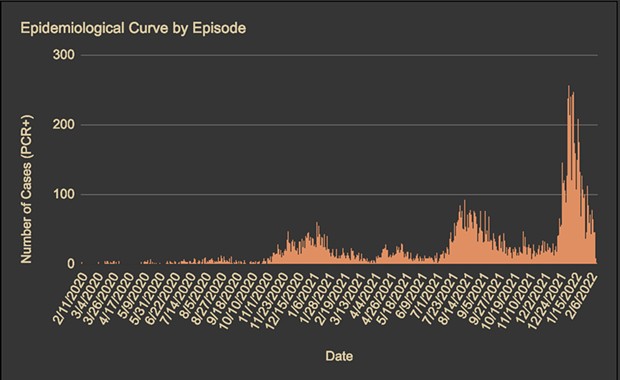[
{
"name": "Top Stories Video Pair",
"insertPoint": "7",
"component": "17087298",
"parentWrapperClass": "fdn-ads-inline-content-block",
"requiredCountToDisplay": "1"
}
]
For the better part of two years now, as we've navigated this COVID-19 pandemic, each of us has repeatedly been forced to reassess and adjust as conditions changed and new information came to light. We've gone from wiping down surfaces and groceries to upgrading ventilation systems and buying better masks, from distance learning back to modified classrooms, and generally adapted from variant to variant. We at the Journal have done the same, continually re-evaluating how to use our limited resources to bring our readers the most important information available and help them make sense of it.
Reporting on Humboldt County's COVID-19 dashboard has been a daily ritual here at the Journal. Every afternoon, we look at the reported number of new cases of the virus, hospitalizations and deaths, as well as testing and vaccine data, and then rush to put the day's information into context for our readers. It's been a worthwhile ritual but it's one that's coming to an end. It's time for us to adapt to a changing landscape and put our limited staff time into reporting that will better help North Coast residents as we all continue to navigate this pandemic.
Before we explain why we've decided to make this change, we feel the need to make one thing very clear: The pandemic is not over. This doesn't symbolize the end of our COVID-19 coverage, just as the lifting of Humboldt County's mask mandate doesn't mean there won't be any more local deaths or surges. As much as we all desperately want to move on from this, we're going to be living with COVID, its threats and reverberations well into the future. And we'll keep writing about them.
What this decision does mean is that we no longer feel the daily case report is worth our daily time, or yours, for that matter. Here's what plays into this decision.
Perhaps most importantly, the use of rapid home tests has become widespread. Amid the understandable urgency of getting these tests widely manufactured and available to the public, the government failed to put any automated reporting mechanism in place. On any given day, there's no way to tell how many rapid tests were administered locally or how many of them came back positive. With reason to believe hundreds of these tests are being administered daily in Humboldt County, that's a huge piece of the picture of disease spread that's simply unavailable to us.
There are also issues with the numbers we do see. The county's dashboard reports cases confirmed from a number of laboratories that process testing samples at varying speeds. That means, on any given day, the dashboard reports "new cases" from testing samples taken over a period of up to a week or more. The "tests" it reports daily, meanwhile, are tests that were administered locally the day prior to the report. This means there is no correlation between the number of cases confirmed on a given day — or week — and the number of tests reported over the same time period, making it impossible to independently and accurately calculate and compare test-positivity rates and other meaningful indicators of disease spread over time.
The county also handles COVID case data and test-positivity rates differently than the California Department of Public Health. While the state tracks numbers of tests and cases — ignoring the fact that those will invariably include duplicates of people who test multiple times, perhaps looking for a negative result that will allow them to return to work or a positive one that will qualify them for sick pay — the county "de-duplicates" that data. This makes it difficult to draw meaningful comparisons between state data sets and local ones, and also means the county is constantly working backward to adjust its case counts to remove duplicates. (For example, those 100 cases reported today might mean the county received word of 120 new cases but is retroactively removing 20 others found to be duplicates from prior reports.)
The county is aware of these issues. Public Health Director Sofia Pereira hinted at some of them during a press conference last week, saying that "certain data has become more or less reliable" over time and the current daily case report "doesn't give us the full picture like we used to have." She said the county will soon move to reporting testing data three times a week instead of five, and is also working on a new dashboard. (When the new dashboard launches, Public Health says it will use the same formula for test-positivity rates as CDPH, which should allow for more meaningful comparisons.)
It's worth adding that at this stage in the pandemic, even accurate daily case counts shouldn't impact people's behaviors and risk calculations. The bottom line is that Omicron continues to circulate widely in Humboldt County and residents should behave accordingly, whether 50 cases were confirmed yesterday or 500.
With all that in mind, we'll continue looking at testing reports and the dashboard daily, and when there are noteworthy things — confirmed deaths, significant jumps or declines in the hospital census, bumps in vaccination totals, identifiable trends — we'll report them. But dropping the daily reporting ritual will allow our reporters to devote the time saved to working on more meaningful, in-depth stories that better help readers navigate and make sense of the pandemic and its impacts.
Thadeus Greenson (he/him) is the Journal's news editor. Reach him at 442-1400, extension 321, or [email protected]. Follow him on Twitter @thadeusgreenson.
Comments
Showing 1-1 of 1
more from the author
-
Campus Closed
Fallout from protests at Cal Poly Humboldt continues
- May 9, 2024
-
Man Shot by Deputy Last Month Dies
- May 8, 2024
-
CPH University Senate Calls for Independent Investigation into Protest Response
- May 7, 2024
- More »
Latest in Editorial
Readers also liked…
-
Failed Leadership
- May 2, 2024
































